I recently came across this map of Pyongyang printed in 1946:
Click map to see full size version
According to the map, it is “For use by War and Navy Department Agencies only. Not for sale or distribution”.
I thought it would be fun to add the map to Google Earth so I could compare the pre-Korean War city infrastructure with what we see today. Some interesting information emerges:
1. The Omura Silk Mill is now the Kim Jong Suk Pyongyang Silk Mill. Satellite image here.
2. The Kanegajuchi Spinning Mill is now the Pyongyang Textile Mill. Satellite image here.
3. Fuji Iron Works is now the Pyongyang Cornstarch Factory. Satellite image here.
4. What was the Pyongyang Airport is now Taedonggang-district in East Pyongyang.
5. Much of what we call the “Forbidden City” (Korean Workers Party Offices) were military barracks.
6. The former Pyongyang Medical College is now … the Kim Il-sung University College of Medicine. Satellite image here.
7. The Supreme People’s Assembly sits on the grounds of the former Pyongyang Women’s Prison.
8. The Namsan School was torn down and is now either the Organization and Guidance Department (according to one defector) or the Democratic Women’s Union Hall. Satellite image below:
I also might have discovered several Japanese colonial-era prisons that may very well still be prisons and/or factories. According to the map, this was the shape of the Pyonysang (Heijo) Prison:
There are a handful of buildings in the DPRK which still retain this distinctive shape (or the obvious remnants of this shape)—as well as walls and guard towers. They are in Phyongsong, Hamhung, and Sariwon:
I have made the 1946 map available as a Google Earth download. You can obtain the KMZ file by clicking here. Please let me know if you make any interesting discoveries of your own.
By coincidence, Andrei Lankov wrote an article about the history of Pyongyang last week in the Korea Times (as I was comparing the maps). According to the article:
Pyongyang enjoyed boom in colonial era
Korea Times
Andrei Lankov
12/30/2010This city is long gone. No, it is still on the maps, and all our readers know its name ― Pyongyang, the capital of the Democratic People’s Republic of Korea.
But the Pyongyang of the Kims’ dynasty does not have much to do with the old city, wiped out in the social turmoil of the late 1940s and inferno of the American bombing of the early 1950s.
People who nowadays inhabit the North Korean capital, are overwhelmingly newcomers, and not much physical evidence is left from the city past.
It was once a capital of Goguryeo, one of the three ancient kingdoms which fought over the domination of the Korean Peninsula in the first centuries of the Christian era. Pyongyang remained important for centuries. During the Joseon Kingdom (1392-1910) it was the second or third largest city in the entire country.
The city remained surrounded by the stone walls which by the 1890s had been in a state of disrepair for a long time (they had lost any military significance since a much earlier date, one has to admit). The majestic Taedong Gate, facing the river, was seen as a masterpiece of traditional architecture.
Throughout the colonial period, the city’s population increased from 40,000 around 1910 to 285,000 in 1940. It was roughly one third of the then size of Seoul, but this still made Pyongyang one of the largest cities in the nation.
As was the case with nearly all major cities of both the to-be North and to-be South, the railway was instrumental in Pyongyang’s growth.
Pyongyang was located straight on the Busan-Seoul-Sinuiju line, built in the early 1900s. This line became a backbone of the country’s transportation network, and old cities which were bypassed by this railway, eventually went into decline. Pyongyang was lucky to avoid such a fate.
Nowadays Pyongyang Station is located close to the center of the North Korean capital. However, in the early 1900s it was located some distance away from the old walled city, so the space between the station and walls became a new part of Pyongyang, with rectangular grid of streets and the numerous houses of the Japanese settlers who comprised about 13 percent of the city population in 1945.
The army barracks and a large military area appeared near the station as well. Meanwhile, the Koreans were left within the space once occupied by the old walled city.
The fast growth of the city made public transportation necessary, and indeed in May 1923 a tram service ― or “streetcars” as Americans would say ― was introduced, to remain in operation until the autumn of 1950 (the present-day tram system was built anew in the early 1990s, and has no continuity with the old trams of the colonial era).
Since time immemorial and until the late 1920s, Pyongyang was located on the eastern (left) bank of the Taedong River, but from the late 1920s the city crossed to the opposite bank as well.
In 1921, an airfield was built there, to be used by both the Japanese air forces and civilian planes which landed there for re-fueling on their way from Japan to China and back. This airfield, located roughly where the “embassies quarter” is now, remained in operation until the late 1950s, if not longer.
Pyongyang underwent a major industrial boom in the colonial era. Huge coal deposits were discovered around the city, so by the 1920s the mines of the Pyongyang area provided about a half of all coal produced in Korea. This economy of the era was largely an economy of coal and steel, so these mines attracted heavy industry.
The Mitsubishi Group built a large steel mill in Nampo, not far away from Pyongyang. Another major consumer of high-quality coal was the Imperial Navy ― and the ship engines of the era were very demanding when it came to the coal quality.
Pyongyang itself also had a number of smaller businesses, including textile and footwear factories. Their presence also meant a presence of powerful labor unions, so Pyongyang was a place of some of the largest strikes of the period.
For the Koreans of the colonial time, Pyongyang was a city of Christianity. Indeed, Protestants constituted up to 25-30 percent of its population.
In a time when nationwide the share of Christians did not exceed 1 percent, this was a truly remarkable figure. This implied a large missionary presence but also existence of first-class educational facilities: Protestant schools played a major role in introducing modern science and technology to Korea.
The result was strength of the nationalist movement then closely associated with Christianity. Contrary to what one might expect, prior to 1945 Pyongyang was a stronghold of the nationalist Right while the Communists position appeared much stronger in Seoul.
The city also boasted a number of museums, including a large archeological museum with the findings made during the excavations of the 1920s.
Not much is left of that city. Most of Pyongyang’s population left in 1945-53, fleeing either religious persecution by the new regime or U.S. bombing raids. These raids virtually wiped the city off the face of earth, so in the mid-50s Pyongyang was built anew without any references to the then rejected past.
A few historical monuments of ancient times have been restored (or rather built), but almost nothing has survived from the colonial era Pyongyang. Only the old Taedonggyo Bridge still crosses the river, handling a large part of very heavy Pyongyang traffic.
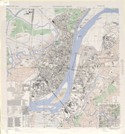
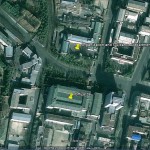
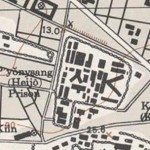
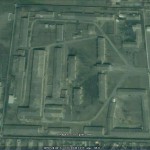
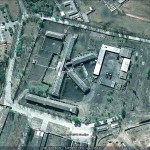
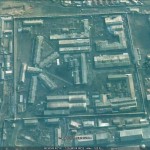

Try doing the same thing for Konan/Hungnam. I’m going to right now.
It seems that the Fuji Iron Works complex was already involved with cornstarch processing before it became the Pyongyang Cornstarch Factory, since the key to the 1946 map identifes it as having a “glucose refinery” (no. 6) and a “dry starch house” (no. 8).
“handling a large part of very heavy Pyongyang traffic.”
Is that sarcasm?
Hi, Is it possible to share the name of the book you got the map from (is that master Yoda’s english ?;D)
thanks
The 1946 map is from the Perry-Castañeda Library Map Collection at the University of Texas at Austin.